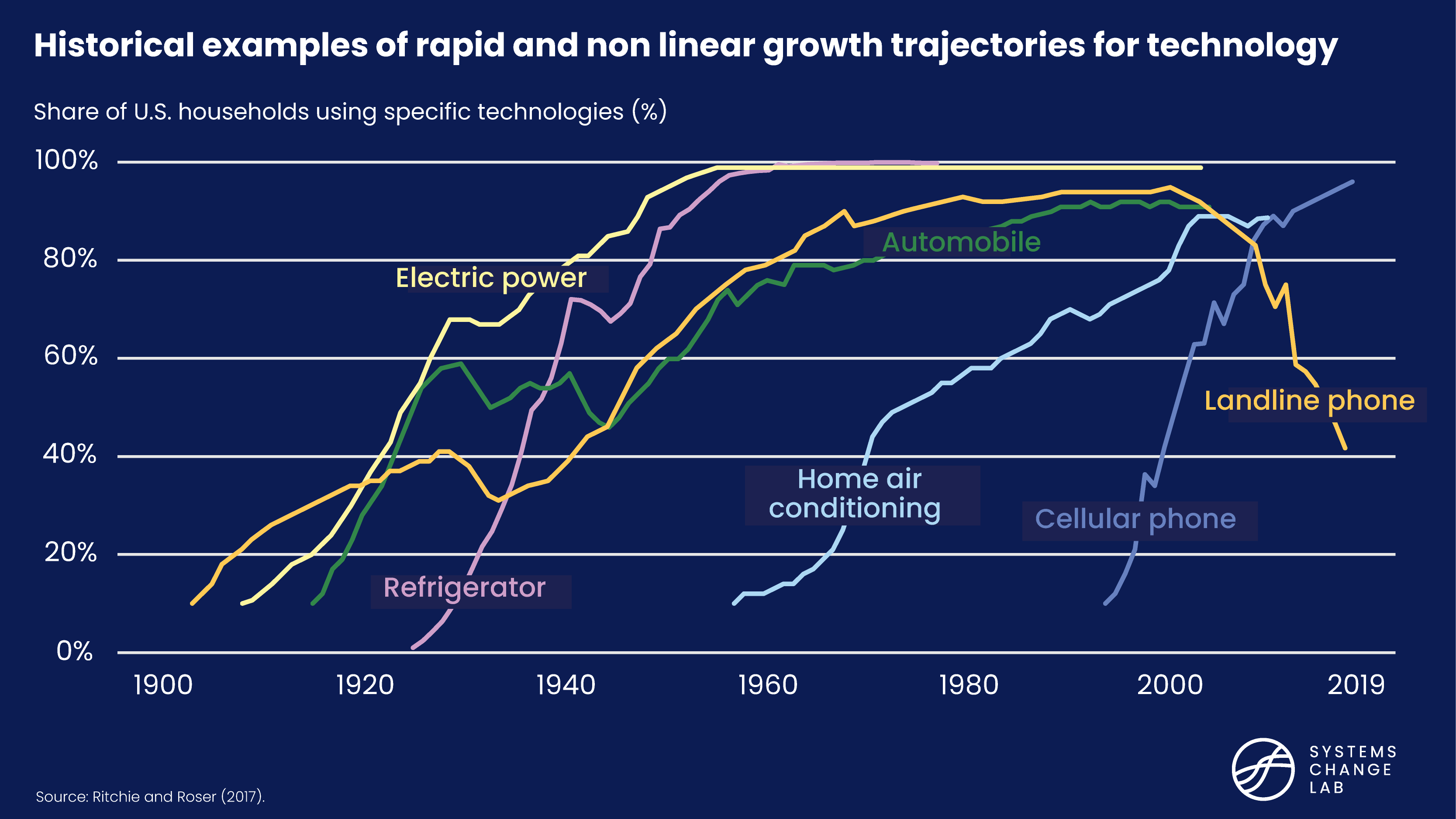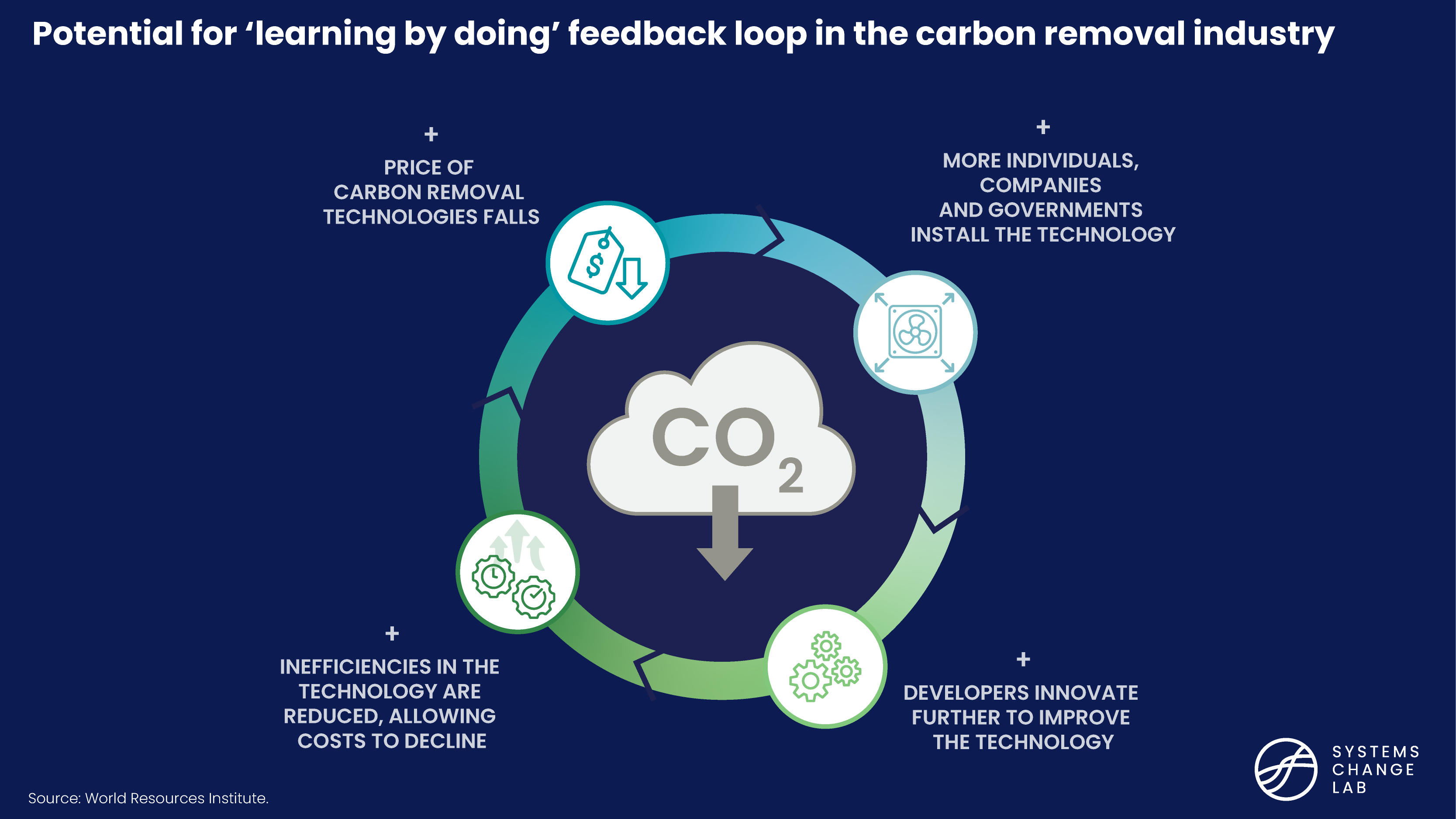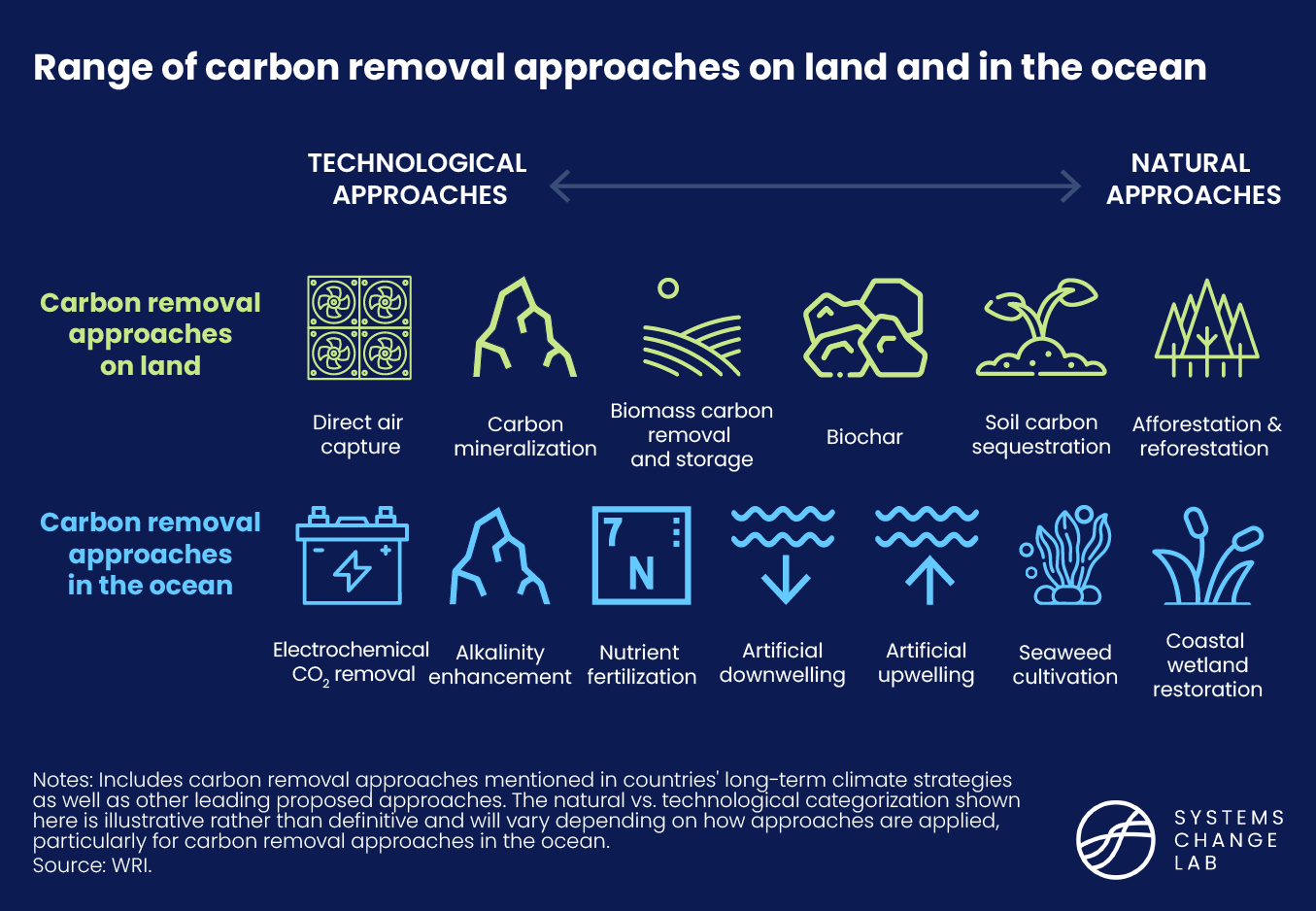The most authoritative climate scientists have made it clear that all pathways which limit warming to 1.5 degrees C (2.7 degrees F) will require carbon removal alongside deep and rapid emissions reductions. Estimates vary, but most include multiple billions of tonnes of technological carbon removal annually by midcentury.
Technological carbon dioxide removal (CDR, or carbon removal) includes many different types of processes and technologies that remove carbon dioxide directly from the air and permanently store it. Direct air capture, for example, uses fans to push air over chemicals that scrub CO2 from the air, after which it can be stored underground, while carbon mineralization accelerates natural rock weathering reactions that take up and permanently store CO2. As the world moves toward net zero, carbon removal will be needed to compensate for residual emissions for which emissions reduction approaches are technologically or otherwise infeasible.
However, carbon removal technologies and approaches are not yet used at scale. While policy and investment momentum has grown significantly in the past five years, today, less than 1% of even the lowest projected need for technological carbon removal is being met. This indicates a large carbon removal gap between the amount of carbon removal happening at present and what will likely be needed to achieve net-zero emissions globally. Getting on track to meet both near-term and midcentury targets would mean drastically accelerating the recent rates of growth for technological carbon removal.
We know that enormous gaps between present trends and future needs are common across many indicators of climate action. However, for many climate solutions — particularly those reliant on technologies — large-scale diffusion of the solution may occur more quickly after the sector crosses “positive tipping points” that can trigger rapid and nonlinear growth.
So, can the technological carbon removal industry reach such tipping points? If so, what kinds of supportive policy, financing and infrastructure interventions can be implemented to reach them?
What Does It Take to Reach a Positive Tipping Point?
A positive tipping point is a point at which reinforcing feedback loops acting within a social system, such as a sector, trigger transformational change of that system. These reinforcing or “positive” feedback loops can take many forms, but are generally understood as scenarios in which some increase in a given variable leads to further increases in that same variable, thus driving rapid and nonlinear change. For instance, a reinforcing feedback loop is at play when greater deployment of a technology leads to lower costs, and then those lower costs lead to even greater deployment.
Consider renewable energy technologies. When individuals, companies and governments purchase and install renewable energy technology, developers of that technology are incentivized to continue innovating to improve it and meet growing demand. As they innovate, they may discover inefficiencies in their supply chains and processes which can be reduced to save money. This allows the price of the renewable energy technology to fall, and further incentivizes new buyers to install the technology, thus starting the loop again.
| Specific types of positive feedback loops that can trigger a social tipping point include |
|---|
| Learning by doing: Where the deployment of a technology leads to greater innovation that improves the product and lowers the cost as production is optimized, this increases the net benefits and encourages further deployment. |
| Economies of scale: Where increased scale of production spreads fixed costs across greater volumes, and leads to more effective division of labor, this lower unit-costs of production and in turn encourages increased rate of output. |
| Technological reinforcement: Where the more something is used, the more additional technologies or practices emerge that make it more useful. |
| Network and coordination efforts: Where the more economic agents take a similar action, the greater the advantages to others of doing the same. |
| Self-reinforcing expectations: Where expectations on future market size trigger investments that grow the market, therefore meeting/exceeding expectations and triggering further investment. |
| Contagion of social norms: Where new solutions can spread rapidly through social communication after crossing into early majority adoption (also referred to as Roger’s Law.) |
When these reinforcing feedback loops are at play within a system, conditions are ripe for rapid and nonlinear growth in adoption of a technology to take off, as one positive development leads to another. Use of targeted interventions to address barriers can help accelerate movement toward these reinforcing feedback loops. Depending on a technology’s development stage, such interventions can be enacted through public policy — for example research, development and demonstration (RD&D) funding, awareness raising, demand creation and more.
Can the Carbon Removal Industry Experience Reinforcing Feedback Loops?
When considering the potential for a system like the technological carbon removal industry to cross a positive tipping point, we can search for reinforcing feedback loops within that system – and identify what barriers they face and what policy or other interventions could accelerate reaching them.
Although nascent, growing evidence suggests that today’s emerging carbon removal industry could experience some of these positive feedback loops, which we know to be prerequisite for a larger positive tipping point phenomenon.
Learning by doing
For instance, carbon removal technologies may benefit from “learning by doing” feedbacks, where costs spiral downward as increases in demand drive innovation. As these costs decline, demand increases further, leading to faster and faster growth. This positive feedback has been present in many technological growth trajectories of the past, including household refrigerators, cars and cellphones, each of which have experienced rapid and nonlinear historical growth trajectories.

Some low-carbon technologies are seeing similar adoption trajectories today. For example, solar and wind technologies, which are now the cheapest forms of new-build electricity generation for two-thirds of the world’s population, continue to grow at rapid, nonlinear rates. For carbon removal, recent analysis suggests that innovation and efficiency improvements may drive cost declines of up to 60% by 2035, after which costs will continue to fall further.

Economies of scale
“Economies of scale” feedbacks — where increased production leads to lower per-unit costs and greater output — may also kick in for some carbon removal technologies such as modular direct air capture (DAC) systems, which involve many identical stacked capture units.
For example, Climeworks commissioned a 36,000-tonne-per-year DAC plant, known as Mammoth, in May 2024. This is a roughly ten-fold scale up of its earlier Orca DAC plant, which captured 4,000 tonnes per year and before May was the largest commercial DAC facility in the world. Learnings from Orca allowed Mammoth to reduce capital expenditures by 10%-20%, increase recovery efficiency by 15%, and reduce operation and maintenance costs by 2-fold, as noted by Climeworks’ CEO at the Mammoth plant’s unveiling. This growth trajectory, along with cost and technological improvements, indicates that economies of scale and learning by doing feedbacks are likely at work.
Self-reinforcing expectations
The growing carbon removal industry may also experience “self-reinforcing expectations” loops. These happen when expectations of future market size trigger investments that grow the market, therefore meeting or exceeding expectations and prompting further investment. The last several years have seen an explosion of interest in CDR technologies, with research papers on the subject, patents for removal technologies and social dialogue about CDR all growing rapidly. As interest and investment in these still relatively niche technologies has grown across different stakeholder groups, many have projected an enormous future market and are making large investments accordingly.
In 2022, a coalition of companies including Stripe, Meta and Alphabet (Google’s parent company) launched Frontier. Frontier is an advance market commitment to buy more than $1 billion of technological CDR from suppliers between 2022 and 2030. Because this supply does not yet exist, the group’s stated goal is to “send a strong demand signal to researchers, entrepreneurs and investors that there is a growing market for these technologies.” The idea is that this will stimulate increased development and delivery of technological CDR to build the market that has been projected.
It’s important to note that while purchases of carbon dioxide removal are beginning to experience nonlinear growth, the amount of carbon actually being removed is increasing more slowly, because these purchases are generally for removal to be delivered at a later date. As more years of data become available, growth trends for delivered carbon removal will become clearer.
Targeted Interventions Can Help Activate Positive Tipping Points
As the authors of The Global Tipping Points Report argue, positive feedback loops and social tipping points don’t “just happen.” Actors in both the public and private sectors must work to actively enable them “by stimulating innovation, shaping markets, regulating business and educating and mobilizing the public.”
There are a variety of theories about how to effectively enable reinforcing feedback loops that can lead to positive tipping points. Many of these boil down to strategic policy interventions which improve the affordability, attractiveness and accessibility of a solution. In other words, these are policy and financing measures that render desirable solutions (1) less costly, (2) more popular and socially desirable, and (3) well-supported by required enabling infrastructure.
Here’s what it could take to achieve these goals for the carbon removal industry.
Lowering costs
Technological carbon removal solutions are costly today, and both government and private sector actors have a role to play in lowering these costs. For the government, potential interventions include funding for RD&D projects; incentives such as tax credits to support deployment; government procurement of technological CDR to help build the market; and, potentially in the longer term, compliance policy that would require certain entities to purchase CDR.
The U.S. federal government is an early adopter here. It has already increased annual funding for research and development of carbon removal (up to $140 million in 2023) and is providing $3.5 billion in demonstration funding for four million-tonne scale DAC hubs. It also enhanced the 45Q tax credit, which provides deployment support of $130-$180 per tonne of carbon dioxide captured via direct air capture and stored or used beneficially. The Department of Energy is also undertaking the first direct government procurement program for carbon removal over the next several years.
Private sector interventions can also help reduce costs and build the carbon removal market. These include advance market commitments like Frontier’s as well as prize competitions that stimulate innovation, such as XPRIZE’s $100 million CDR challenge.
Building awareness and trust to improve attractiveness and accessibility
Unlike many other climate technologies, carbon removal is relatively new and unknown. It is also often complex and technical. Communication, education and awareness-building are therefore the first steps to enhancing public perception and increasing the attractiveness of technological CDR solutions. This is especially difficult today, as there are currently few operational projects across the spectrum of approaches. But as more projects become operational, there will be opportunities to point to examples on the ground, which could help address this information gap.
As CDR projects are being developed, prioritizing early and consistent community and stakeholder engagement in potential host communities can help ensure long-term success. Potential host communities need to be aware of details and expected impacts — both negative and positive —associated with potential projects to be able to make decisions about whether they will support it and what level of involvement they want in the process. Mechanisms like legally binding community benefits agreements can codify benefits that will be provided and hold project developers accountable.
Community engagement may also improve project outcomes when community members can provide local knowledge. For instance, in the case of a proposed ocean CDR project, community members could provide information about existing ocean activity like fishing and shipping, dynamics of local fish stocks, and ideas on where and how projects could be sited to minimize negative impacts. This could all help inform the design and implementation of a project.
Simultaneously, trust and public perception of CDR technologies may be improved through policy interventions like adoption of oversight standards for measurement, reporting and verification (MRV) of carbon removal. Consistent and credible MRV is needed to provide accountability to project developers by ensuring that any removals that are occurring are being accurately quantified and transparently reported. When this accountability infrastructure has been built, technologies are likely to become more accessible to developers and buyers that are committed to demonstrating that the CDR they’ve built or purchased is driving permanent removal and storage.
Unique Challenges in the Carbon Removal Industry
Several factors unique to the CDR industry could, however, make it more challenging to achieve positive tipping points compared to other technologies, such as solar PV or electric vehicles, which are already following nonlinear growth trajectories.
First, carbon removal is not replacing an incumbent technology with a lower-carbon alternative that provides the same service (unlike coal and gas being replaced by solar power, or internal combustion engines being replaced by EVs). It is, above all, a public good of atmospheric clean-up that doesn’t have a ready market — unlike electricity or transportation. This means that there isn’t a built-in market for carbon removal; instead, demand must be created through policy or other mechanisms that incentivize or compel people to purchase carbon removal. So, the role of policy — to create demand and support RD&D — in achieving a positive tipping point for carbon removal is likely to be outsized compared to other types of clean technology.
Second, carbon removal includes many different types of technologies and approaches. Not all of these will be equally impacted by the reinforcing feedback loops which may materialize across the industry.

Note: The natural and technological categorization is not definitive but is meant to illustrate the range of approaches. Approaches closer to the technological end of the spectrum may be more susceptible to nonlinear growth and adoption.
For example, some types of direct air capture systems are modular, with identical units that can be produced in rapid succession. These technologies could see prices fall as production increases and becomes more streamlined and optimized. But other carbon removal approaches do not involve the same kinds of manufacturing or repeatable processes. For example, enhanced rock weathering involves adding crushed alkaline minerals to agricultural fields to react with and lock away CO2. This requires more case-by-case characterization of different feedstock materials and agricultural lands to understand the most effective way to apply material to maximize removals.
Lastly, while rapidly increasing technological carbon removal is necessary to meet global climate goals, governments must ensure that it is scaled up in a responsible way that minimizes negative impacts and maximizes benefit for people, the climate and the environment. If the carbon removal industry achieves a tipping point and reaches global CDR targets for midcentury, but relies on unsustainable amounts of biomass that threaten food security and biodiversity, or exacerbates water scarcity, or is used to offset continued fossil fuels production, we’ll still be far from securing a climate-safe future. Robust governance and regulatory guardrails will be critical to ensure that CDR projects are done sustainably, equitably, and don’t take the place of emissions reductions efforts.
Looking Ahead
Technological carbon removal will be needed — at up to a multi-billion-tonne scale within the next several decades — to help reach a net-zero emissions future and avert the worst of the climate crisis. As the carbon removal industry scales up over the coming years, reinforcing feedback loops such as learning by doing, economies of scale and self-reinforcing expectations loops could potentially trigger positive tipping points that unlock exponential growth.
But governments and regulators must be actively involved in driving this progress. The industry will ultimately be dictated by policy or other interventions that require scale-up and purchase of CDR, so targeted policy interventions that improve these nascent technologies’ affordability, attractiveness and accessibility will be paramount.